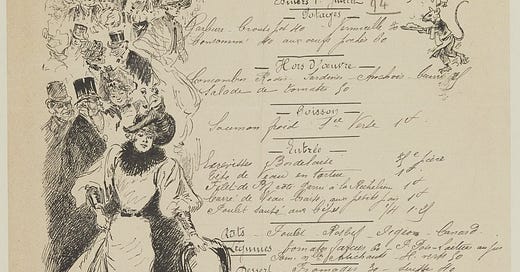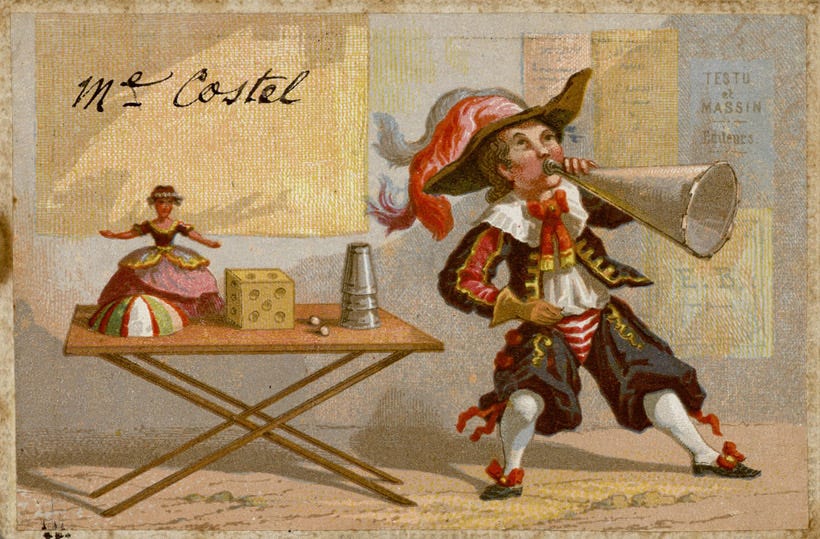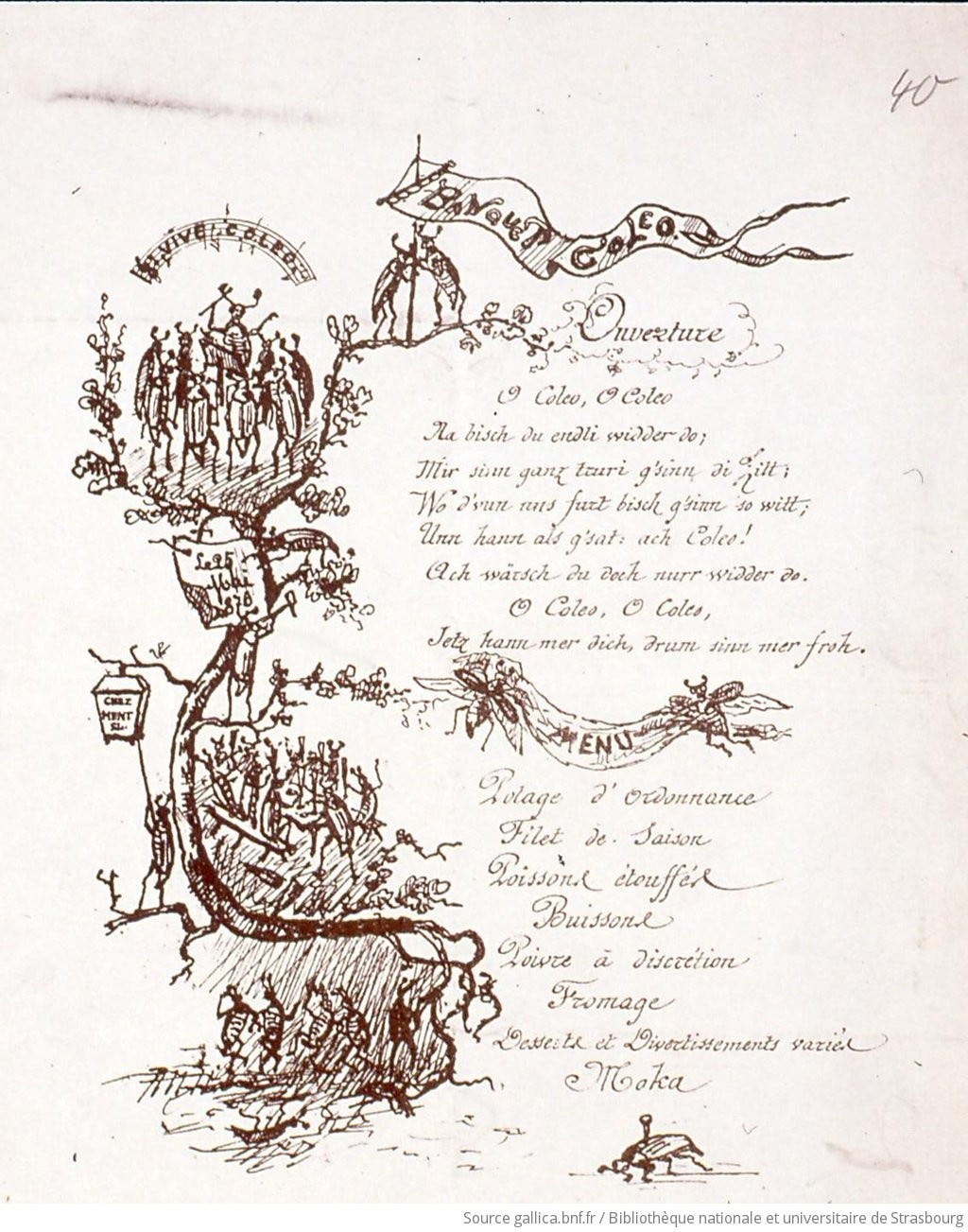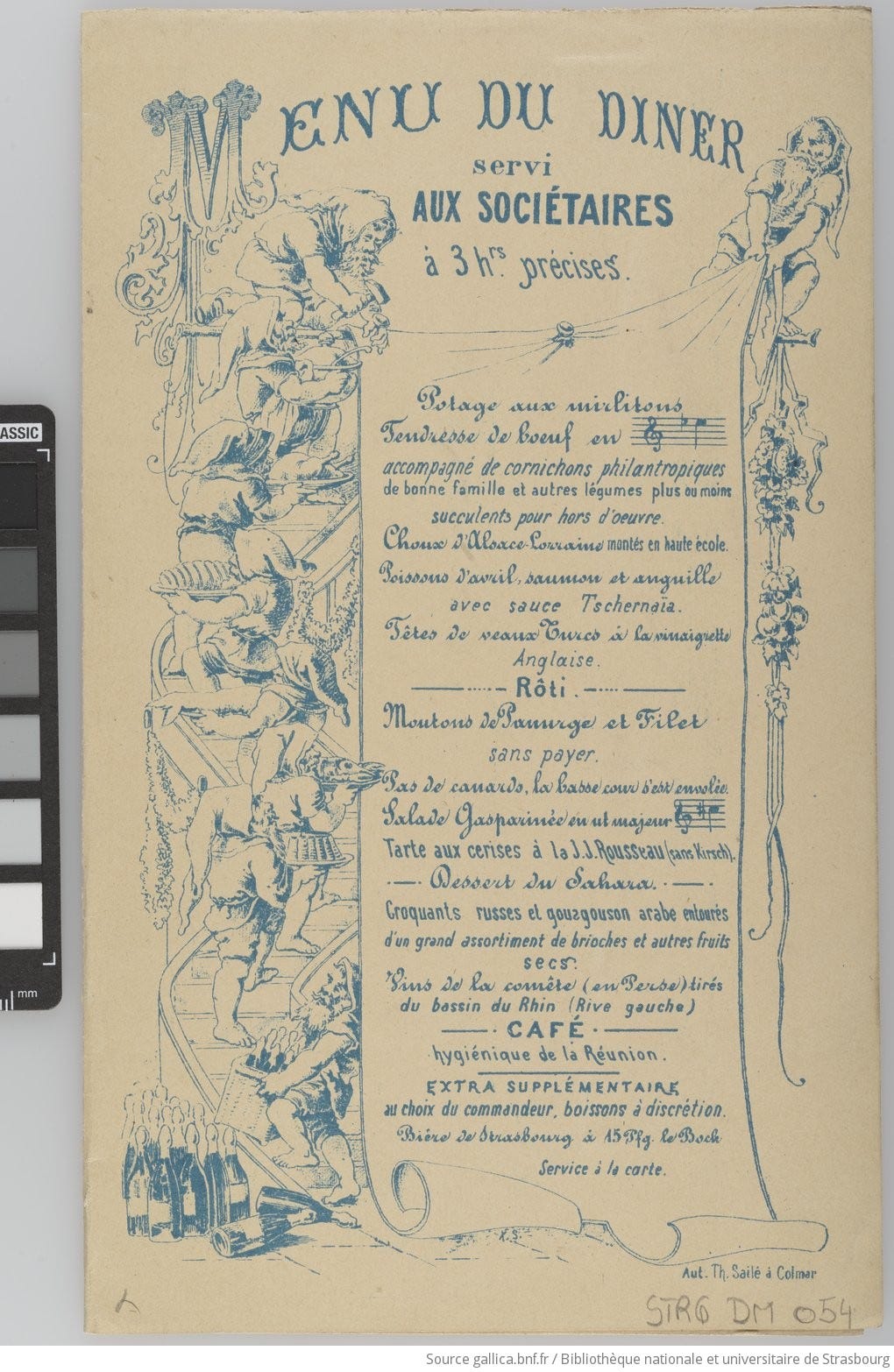I did it again: I made a terrific discovery using the archives of the Bibliothèque Nationale de France and it inspired me for my latest Substack article.
There’s an entire section of menus in the National Library’s digital archives (link at the bottom if you’re curious). I could not help but pore over the glorious illustrations and read through the historic vocabulary of food preparations and styles — though some menus are very hard to read.
Let’s start with the menu above.
It was drawn in 1894 by an Impressionist named Henry Somm, for a popular cabaret and restaurant in the Pigalle area of Paris called Le Rat Mort, or The Dead Rat. This place has a super interesting history and was very popular with bohemians and artists, dancers and prostitutes of the day. (I’ll write a future article about it.)
What’s interesting about this menu, and some of the others I’ve discovered, is that many well-known artists would illustrate them for friends who hosted parties/dinners. Imagine the creative license one would have! I wonder: did they do this for money or for fun?
Let’s stay in Pigalle, with one artist who was prolific with menu illustrations: Henri de Toulouse-Lautrec.
He had quite a life that involved parties, brothels, and dancehalls in Montmartre. He drew menus for many of his friends, like the one below. It’s titled “Le Milliner, Renée Vert”. The front of the menu shows a hatmaker named Renée Vert in her atelier for an event hosted by the Society of Independent Artists from 1893.
Below is another great menu drawn by Toulouse-Lautrec in 1895 (look at the little head floating in the right upper corner, explained below):
When I searched for information about this menu, I came across an auction description from Sotheby’s which explains that:
Toulouse-Lautrec executed the menu to celebrate the opening of his friend Tristan Bernard’s new hit play, Le Pied nickelés. The menu includes two illustrations of Lautrec’s friends and clients. Paul Sescau, who played banjo and host to the banquet at his 53 rue Rodier studio, appears at left. A caricature of Maurice Guibert, a champagne merchant, is in the top right corner. Almost everything in the menu is an inside joke or a reference to a contemporary event, the significance of which has been lost with time.
Incidentally, Paul Sescau was a photographer who had a successful business in Montmartre producing photographic images of artists’ paintings. He was a very good friend of Toulouse-Lautrec; the two patronized several popular artists’ cafes in Pigalle and were well known in those quarters.
A lot of old menus are available from libraries in Dijon and Strasbourg. Below is one from Dijon, dated April 1868. Just look at the adorable illustration:
I don’t know if in the first image the name Madame ‘Costel’ is for the invitee herself or the host. Some of the offerings on this menu include deboned slices of stuffed goose (‘galantine d’oies’), stuffed turkey, and cauliflower with capers.
The menus from Alsace are interesting because the region belonged to Germany until 1945, when it became French territory. Some of the menus before 1945 were in French and German. Here’s a great example:
The first part of the menu is a song or poem in German followed by the menu in French. Also notice that in the illustration to the left are a bunch of beetles, with one on the bottom nailed to the floor. (I tried to research what Vive Coleo was, but I couldn’t find anything.)
Here’s a good one that I found, and which love for its illustration. It features little gnome ‘servers’ carrying food and drink up some stairs. This menu is from 1876, and was for a dinner held by the Fanfare and Choral Union of Colmar (look at the cute little musical notes) in the Alsace region:
Some highlights from this menu include calf’s head, mutton, and fish and eel with ‘Tschneraïa’ sauce - which, when I look it up online, shows Bearnaise sauce, though I’m not sure about that. Dessert appears to be an ode to the Sahara with assorted breads and dried fruits as well as crispy treats. And let’s not forget: dinner is ‘precisely’ at 3pm. I’m willing to bet this was at least a 3-hour meal.
There are hundreds of menus online, possibly thousands, so this is just a ‘taste’ — so to speak — of what’s available. What fascinated me was the illustrators’ personal styles brought to life. I can just imagine someone asking their artist friend to draw up a menu for a swanky party they’re hosting.
Sources:
Menus at the Bibliothèque Nationale de France
Toulouse-Lautrec’s illustrated party menus
Dijon menu history: Les plus anciens menus de la collection – Happy Apicius, Le blog du fonds gourmand













This was such an interesting read! The way you uncover and break down these historical menus makes them feel alive again.
I never would have noticed the little details in the illustrations, but now I can’t unsee them. It’s cool how artists used to create menus like this—makes me wonder how many more hidden gems are out there.
Looking forward to your future article on Le Rat Mort!
Loved these! Thanks for digging them up!